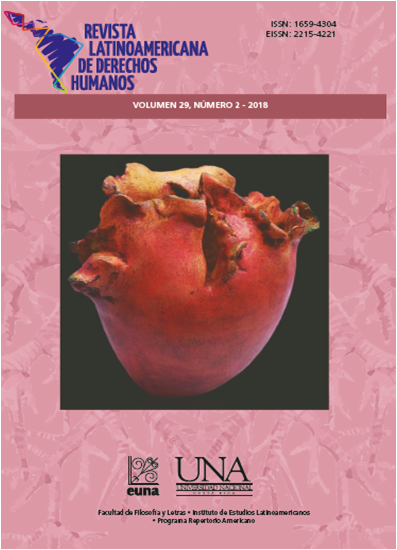United Nations Declaration on the Rights of Indigenous Peoples: A Tool to Combat Inequalities Between Indigenous Peoples and the Globalized Society
DOI:
https://doi.org/10.15359/rldh.29-2.1Abstract
In 2007, the General Assembly adopted the Declaration on the Rights of Indigenous Peoples with the majority of UN member states. The declaration is relevant to anyone in charge of or in contact with indigenous peoples. A central effect of the dominance of globalized culture over indigenous cultures is the asymmetry of perception and mutual influence. Due to the effects of the external social pressure of globalization, indigenous peoples have little freedom of choice. Exercising their right to cultural autonomy in education and lifestyle is very difficult for indigenous groups. On the part of governments, problems related to land rights are an obstacle to recognizing the autonomy of these peoples. Some of the analyzed articles of the United Nations Declaration on the rights of Indigenous People have relevance for external entities, such as groups of researchers or tourists, in contact with indigenous people.
References
Asamblea General de las Naciones Unidas. (2007). Declaración sobre los derechos de los pueblos indígenas. Resolución adoptada [sin remisión previa a una Comisión Principal (A/61/L.67 and Add.1)] 61/295.
Conferencia por la libertad de información de las Naciones Unidas, celebrada en Ginebra del 23 de marzo al 21 de abril de 1948. Ceremonia final. Lake Success NY: Naciones Unidas.
Festinger, L. (1957). A Theory of Cognitive Dissonance. Stanford CA: Stanford University Press.
Gallagher, S. (2005). How the Body Shapes the Mind. Oxford: Oxford University Press. https://doi.org/10.1093/0199271941.001.0001
Groh, A. (2018). Research Methods in Indigenous Contexts. New York: Springer. https://doi.org/10.1007/978-3-319-72776-9
Niedenthal, P. M., Barsalou, L. W., Winkielman, P., Krauth-Gruber, S., & Ric, F. (2005). Embodiment in attitudes, social perception, and emotion. Personality and Social Psychology Review, 9, 184–211. https://doi.org/10.1207/s15327957pspr0903_1
Organización Internacional del Trabajo. (1989). Convenio 169 – Pueblos indígenas y tribales en países independientes (entrada en vigor: 5 Sept. 1991). Ginebra: ILO.
Watzlawick, P., Beavin, J. H., & Jackson, D. D. (1967). Pragmatics of Human Communication. A Study of Interctional Patterns, Pathologies, and Paradoxes. New York: Norton.
Wicklund, R. A., & Gollwitzer, P. M. (1982). Symbolic self–completion. Hillsdale NJ: Lawrence Erlbaum.
Downloads
Published
How to Cite
Issue
Section
License
El material que se publica en esta Revista está bajo una licencia “Creative Commons” 3.0 Costa Rica (CC, Reconocimiento-NoComercial-SinObraDerivada 3.0 Costa Rica (CC BY-NC-ND 3.0 CR) . Esto significa que el material publicado en la revista se puede compartir (copiar y distribuir) en cualquier medio o formato considerando que se debe reconocer de forma adecuada la autoría del material y la fuente, no puede utilizarse con fines comerciales y no se aceptan las obras derivadas (remezclar, transformar o crear a partir del material).








